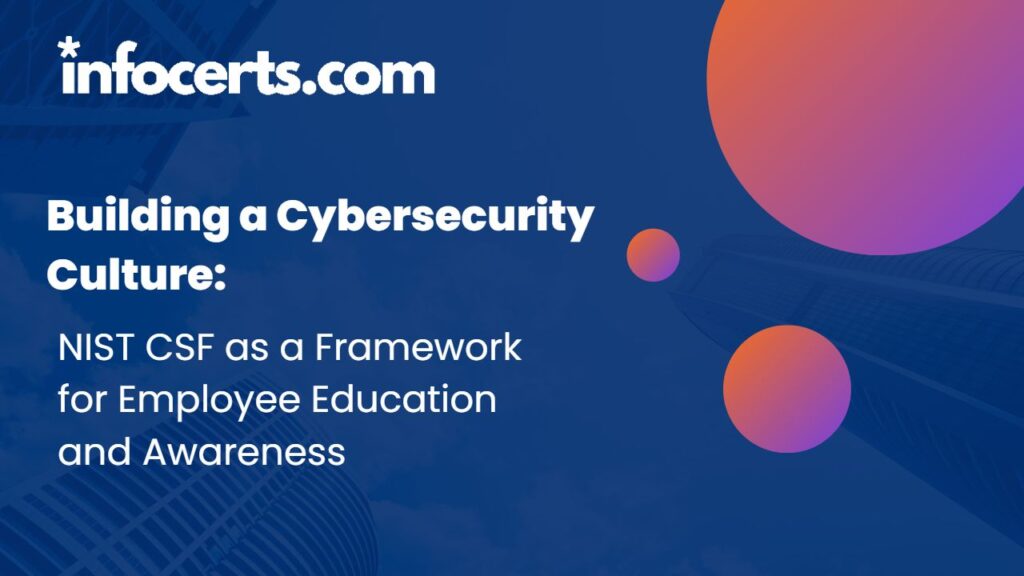Introduction: In today’s digital landscape, organizations face an ever-growing number of cybersecurity threats. From phishing attacks to Ransomware incidents, the consequences of a successful breach can be devastating. To combat these risks effectively, organizations must establish a strong Building Cybersecurity Culture that permeates every level of the workforce. One valuable framework for achieving this is the National Institute of Standards and Technology (NIST) Cybersecurity Framework (CSF). By utilizing the NIST CSF as a foundation for employee education and awareness, organizations can empower their workforce to be active participants in safeguarding critical assets and data.
Education: The first step towards Building Cybersecurity Culture is to educate employees about the risks they may encounter and the measures they can take to mitigate them. The NIST CSF provides a comprehensive set of guidelines that organizations can tailor to their specific needs. By conducting regular training sessions, workshops, and awareness campaigns, employees can gain a deeper understanding of cybersecurity best practices, including password hygiene, identifying social engineering attempts, and securing their devices.
Awareness: Raising awareness among employees is crucial to ensure that cybersecurity remains a priority. This involves fostering a sense of responsibility and vigilance towards potential threats. Organizations can use the NIST CSF to develop customized materials such as posters, newsletters, and internal communications that reinforce cybersecurity principles. Regular reminders about the importance of strong passwords, encrypted communications, and reporting suspicious activities help to embed cybersecurity in everyday routines.
Engagement: Engaging employees actively in cybersecurity initiatives is vital for building a sustainable culture. Organizations can leverage the NIST CSF to establish channels for reporting security incidents, encouraging employees to share their concerns or observations. Additionally, creating opportunities for employees to contribute their ideas and suggestions for improving cybersecurity practices can foster a sense of ownership and involvement.
| Aspect | Example |
| Education | Conducting regular training sessions on password hygiene and identifying social engineering attempts. |
| Awareness | Creating posters and newsletters to reinforce the importance of strong passwords and reporting suspicious activities. |
| Engagement | Establishing channels for employees to report security incidents and encouraging their active participation in cybersecurity initiatives. |
| Continuous Improvement | Conducting periodic evaluations to identify gaps in employee knowledge and refine cybersecurity education programs. |
Continuous Improvement: A Cybersecurity culture is not a one-time achievement; it requires continuous improvement and adaptation. The NIST CSF’s iterative approach supports this by emphasizing the need for regular assessment and adjustment. By conducting periodic evaluations, organizations can identify gaps in employee knowledge or areas that require additional attention. These insights can be used to refine education programs and awareness campaigns, ensuring that the cybersecurity culture remains relevant and effective.
Conclusion: In today’s digital age, organizations must prioritize cybersecurity education and awareness to mitigate risks effectively. The NIST CSF provides a robust framework for building a cybersecurity culture that empowers employees to become proactive defenders against cyber threats. By Leveraging this framework, organizations can educate, raise awareness, engage employees, and continuously improve their cybersecurity practices, ultimately creating a workforce that is resilient and vigilant in safeguarding valuable assets and data.
FAQs
- What is the NIST CSF?
- Why is building a cybersecurity culture important?
- How can organizations use the NIST CSF to educate employees?
- How can organizations engage employees in cybersecurity initiatives?
- Why is continuous improvement important in a cybersecurity culture?
——————————————————————————————————————–
Infocerts, 5B 306 Riverside Greens, Panvel, Raigad 410206 Maharashtra, India
Contact us – https://www.infocerts.com

